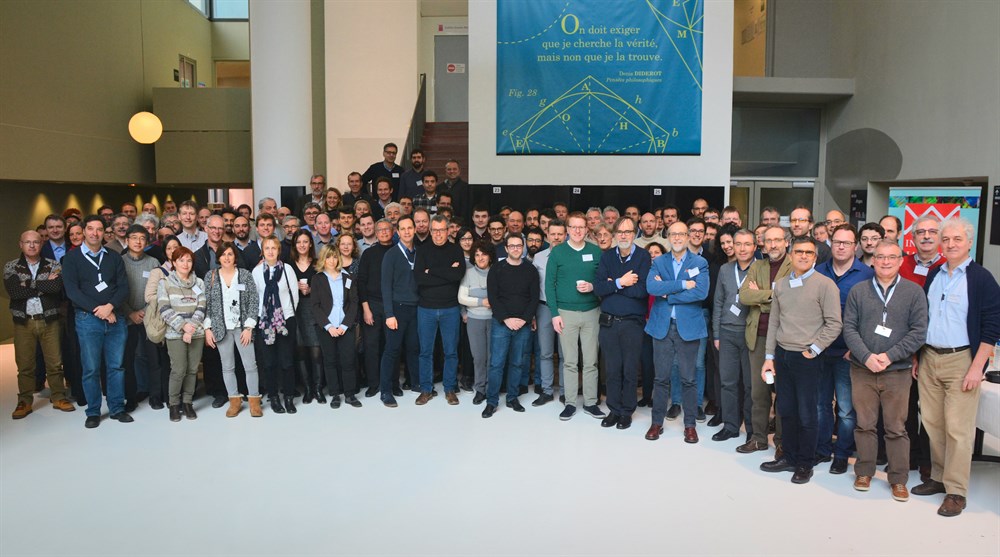
Date.
The 7th consortium meeting spread over a full week was held at the Astroparticle and Cosmology Laboratory (ApC) in Paris from March 19th to 24th. The organization of the whole week was led by Damien Prêle. ApC provides a major component of the X-IFU, namely the so-called warm front end electronics, the closest part of the readout chain to the cold electronics of the X-IFU. Those electronics are a key contributor to the instrument performance, benefiting from the excellent skills of the ApC electronics group.
The meeting was attended by about 140 engineers and scientists from all across the world. 18 splinters were organized before and after the 1.5 day plenary sessions. The plenary sessions featured the usual presentations from the X-IFU Consortium and project leads and ESA.
CM7 will be remembered as the meeting in which a consolidated baseline of the X-IFU was presented by the CNES project team. This closed a very active period of activity of three months. The main changes is that the cryogenic chain now fulfills plainly the 30% margin policy on thermal budgets, even in the more dramatic case of a cooler failure. This was achieved, assuming that the outer vessel of the Dewar would be cooled at 200 K, a lower dissipation at the 2K stage and updating cooler performances. This is a milestone because a stable configuration for the instrument will enable us to hold the IPRR by the end of 2018. Optimization work will still continue until June at least, as some promising options have been identified. The CNES team and all the consortium partners involved should be deeply thanked for this major achievement. A mass non-compliance of less than 30 kg remains, but is modest compared to the 30% system level margins of the 7 ton Athena spacecraft. The baseline configuration was reached while preserving the top level performance requirements of the X-IFU. This clearly shows that before considering de-scopes for the instrument, consolidated design work is required, and this takes time and efforts. Thanks to Thien Lam Trong, our CNES project manager, for getting there without asking me to descope the instrument.
Of the highlights of the meeting, the significant progresses made on the detector cooling system by the CEA-SBT and JAXA team was impressive as 50 mK is routinely achieved in different cooler configurations. The progresses in the TES development and the performance of the baseline readout for X-IFU should also be emphasized. SRON now measures on single pixels a spectral resolution close to 2.5 eV. Next step is obviously to check the performance when pixels are multiplexed. The improvements in the sensor (e.g. higher resistivity devices) helps reading them at high frequencies, when an AC loss phenomena was previously measured with less resistive devices. The need to define baseline parameters for the sensors is now becoming urgent. In parallel, the analysis of Time Domain Multiplexing as a back-up to FDM is progressing well, on track for getting a detailed report by June. Progresses in the definition of several subsystems should also be mentioned, taking advantage of iterations on specifications with the CNES project team.
The science talk by Edoardo Cucchetti on cluster science highlighted the unique capabilities of the X-IFU. The full bread of X-IFU Science Advisory Team activities were presented, before the introduction of the X-IFU instrument simulator (XIFUSIM), whose first release was announced. A report on the WFI technology status was also presented by Arne Rau. The meeting included a presentation by Paul Callanan on a potential Irish participation to the X-IFU, for which PRODEX funding was obtained. It is worth noting that a contribution from Czech Republic is now also being considered for X-IFU, under the leadership of Jiri Svoboda who attended the meeting.
Overall, CM7 was an extremely important meeting, marking a milestone in the project life, because we do have now a stable baseline. Everyone will keep working hard on the consolidation of the baseline.
The next Consortium meeting will be in Geneva from September 10th to 14th, hosted by the University of Geneva, also a key contributor to the X-IFU, through the filter wheel and a large participation to the X-IFU Instrument Science Center. Needless to say that it will be a great success if it brings the same momentum to the X-IFU Consortium as CM7 did.


 Youtube
Youtube